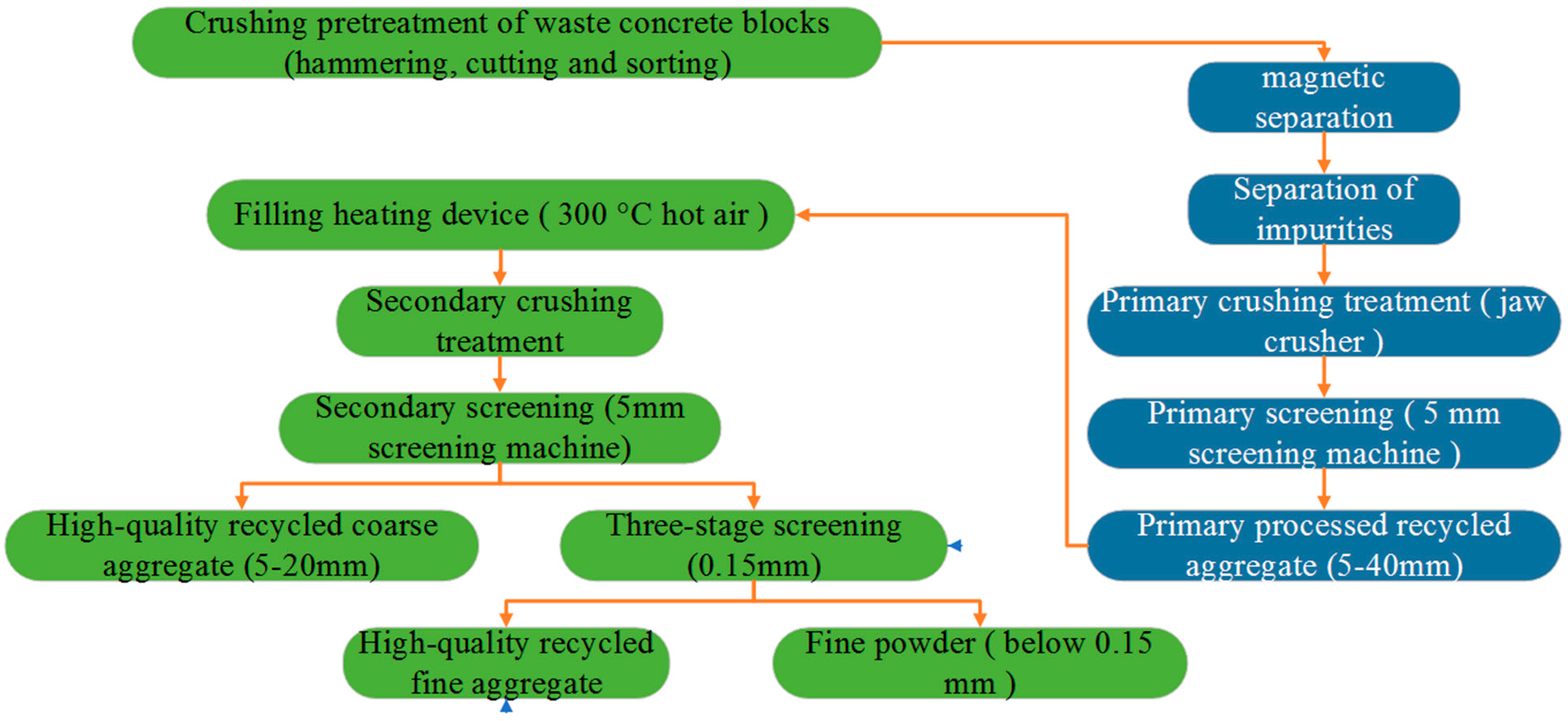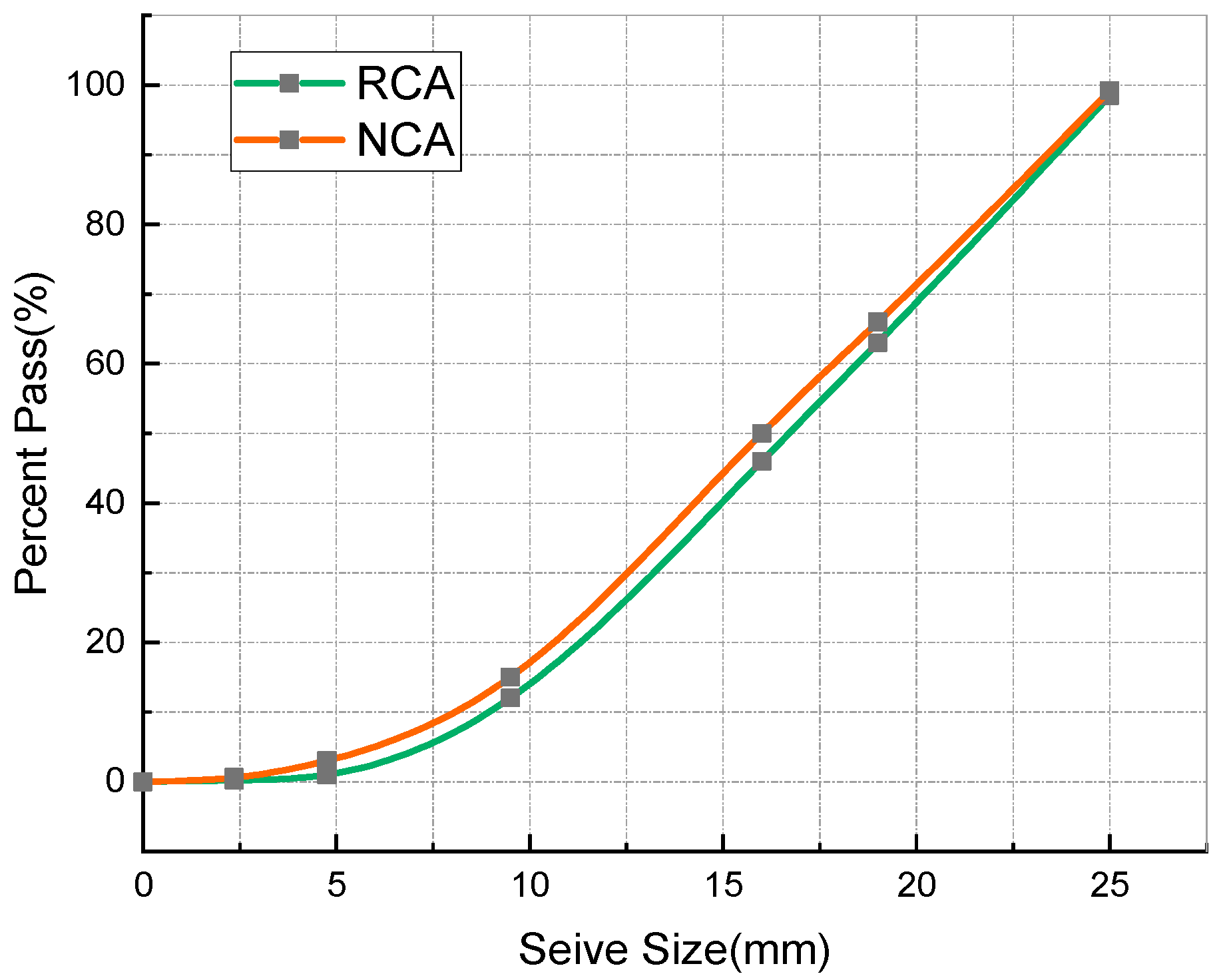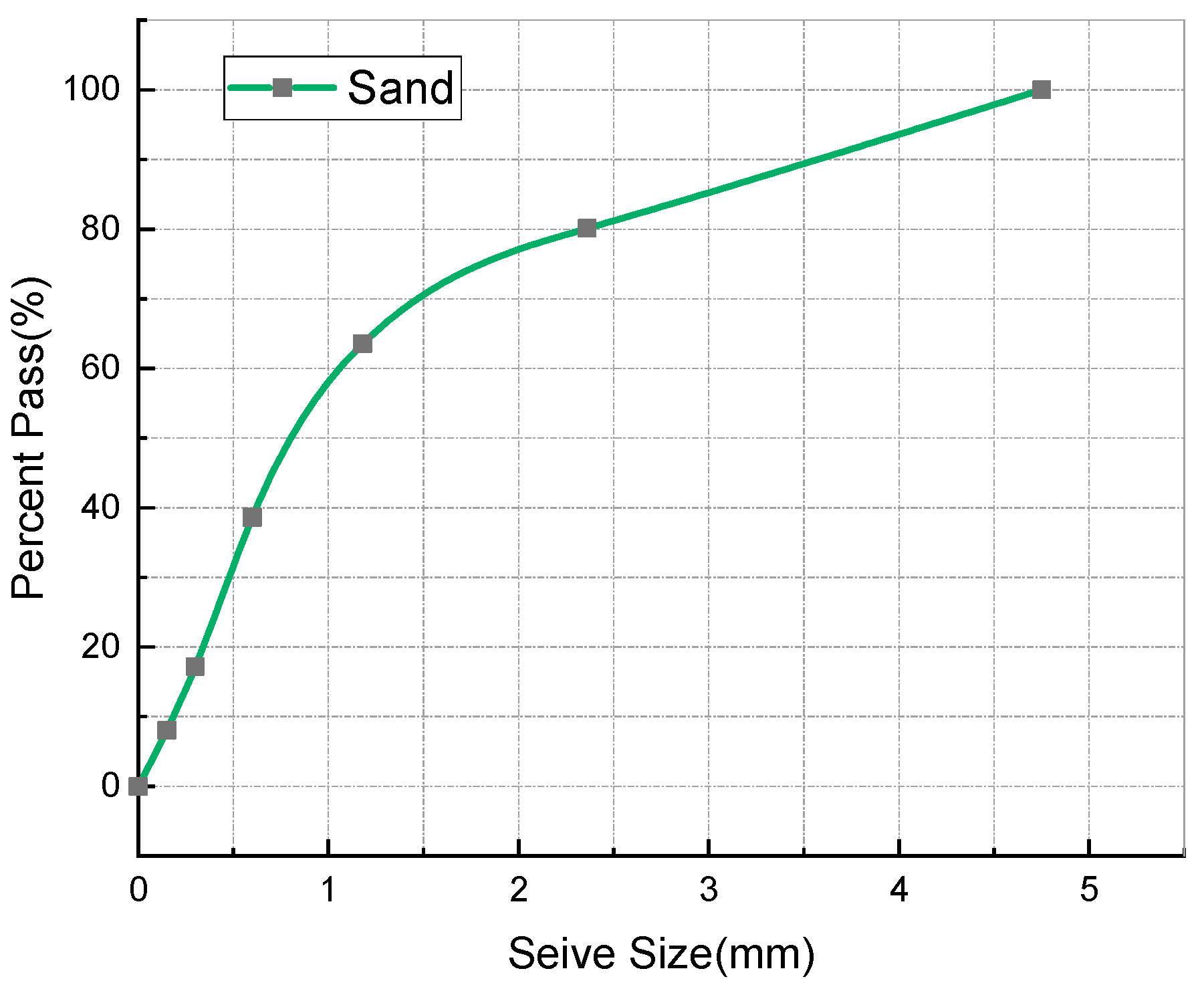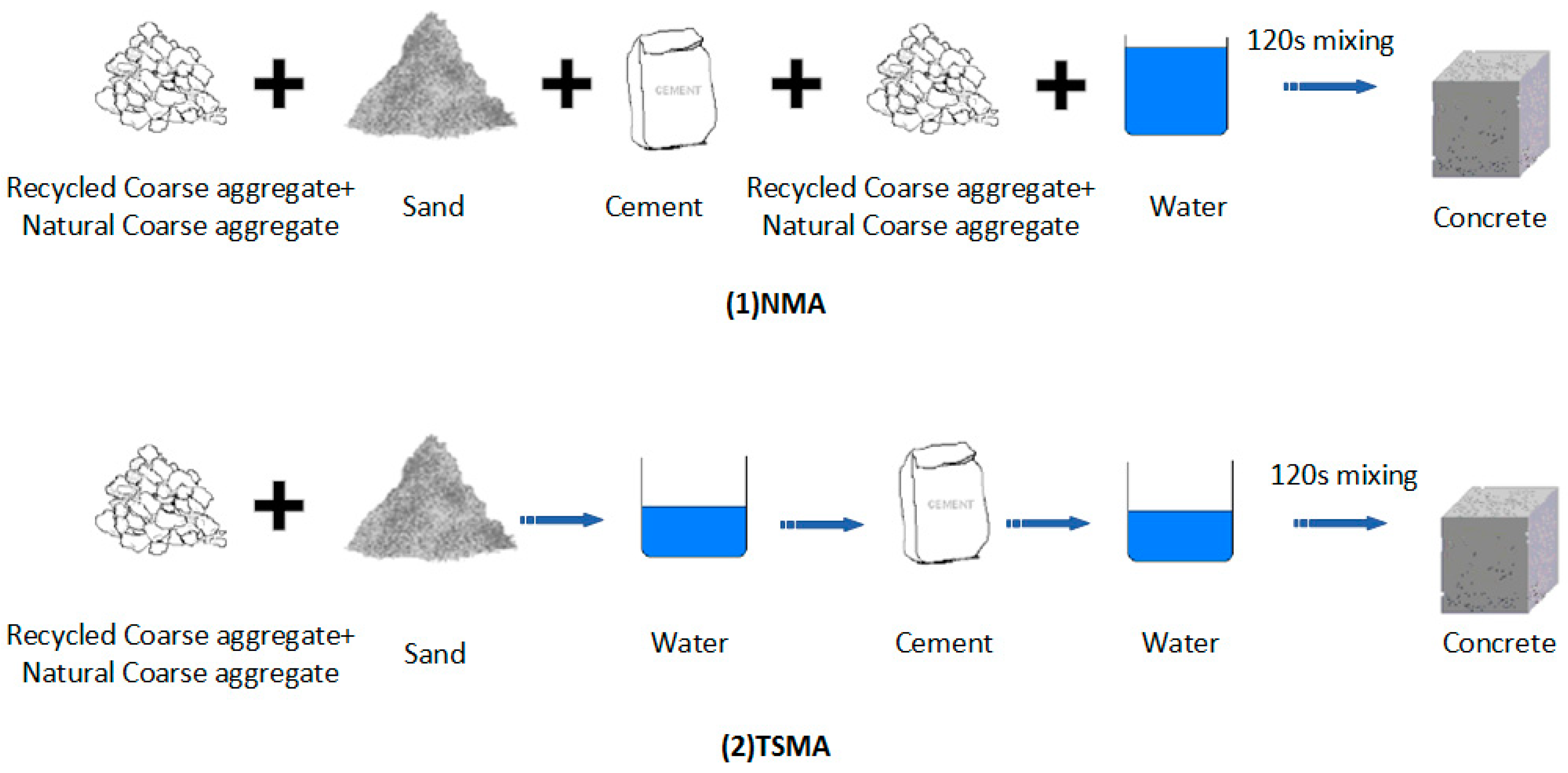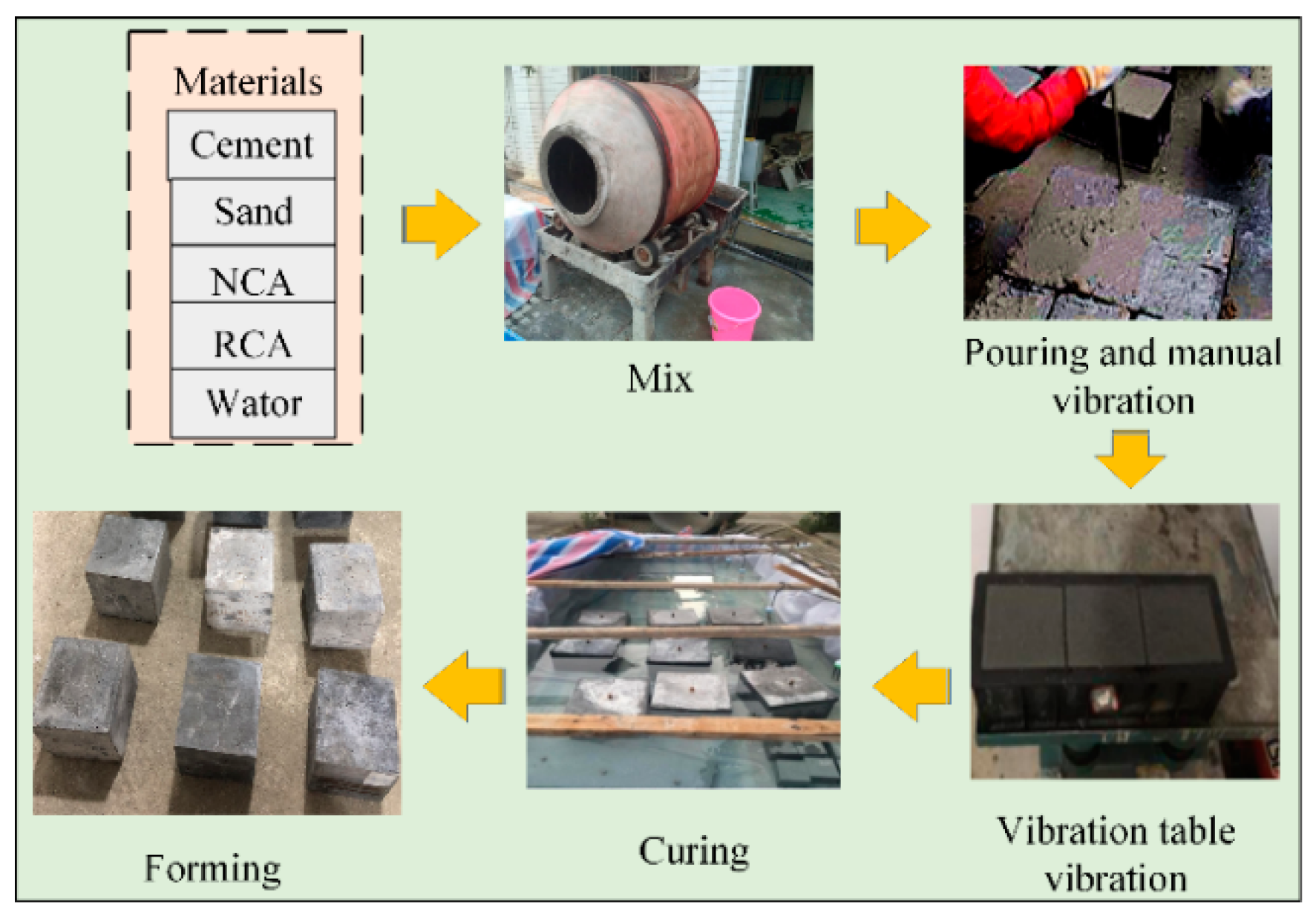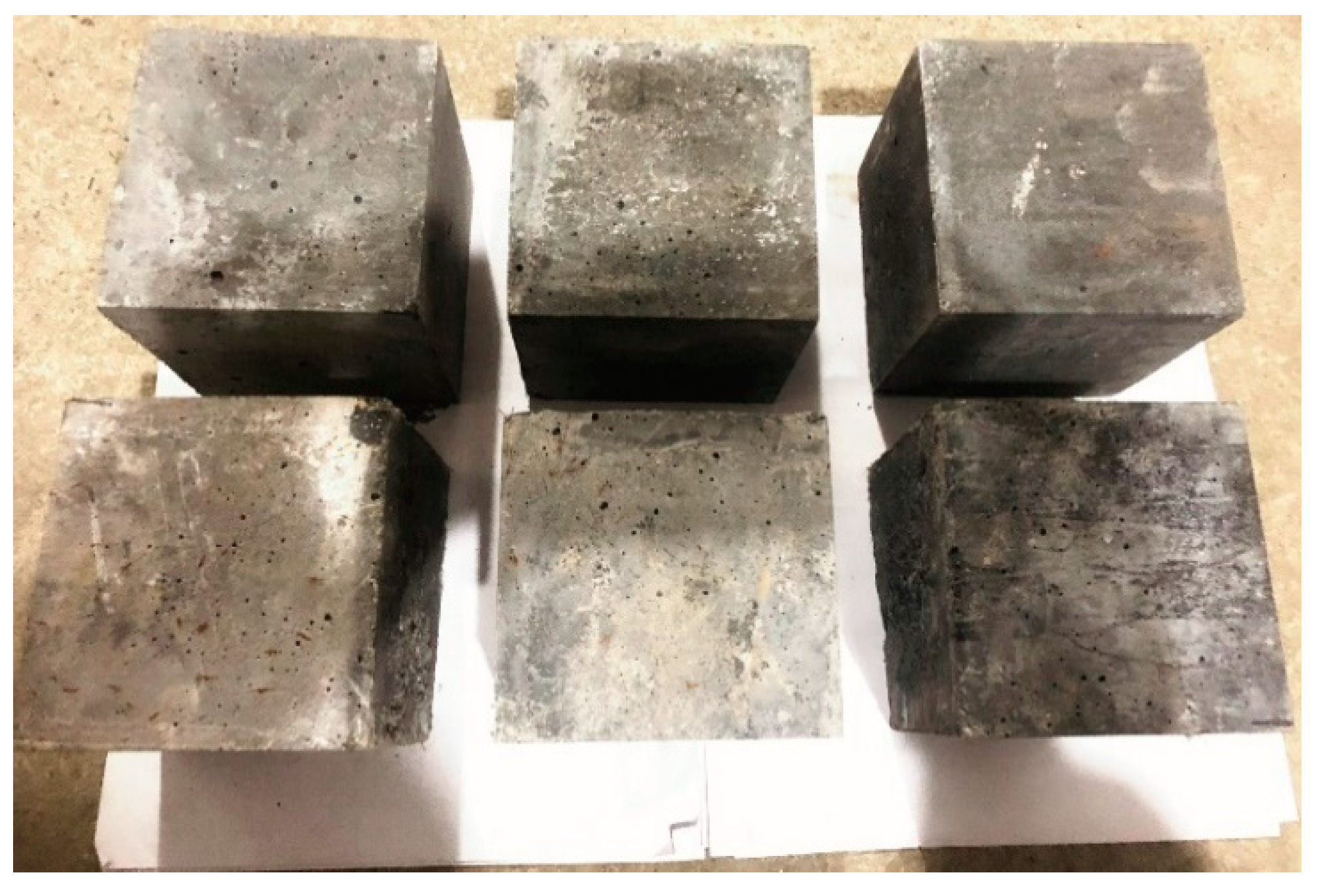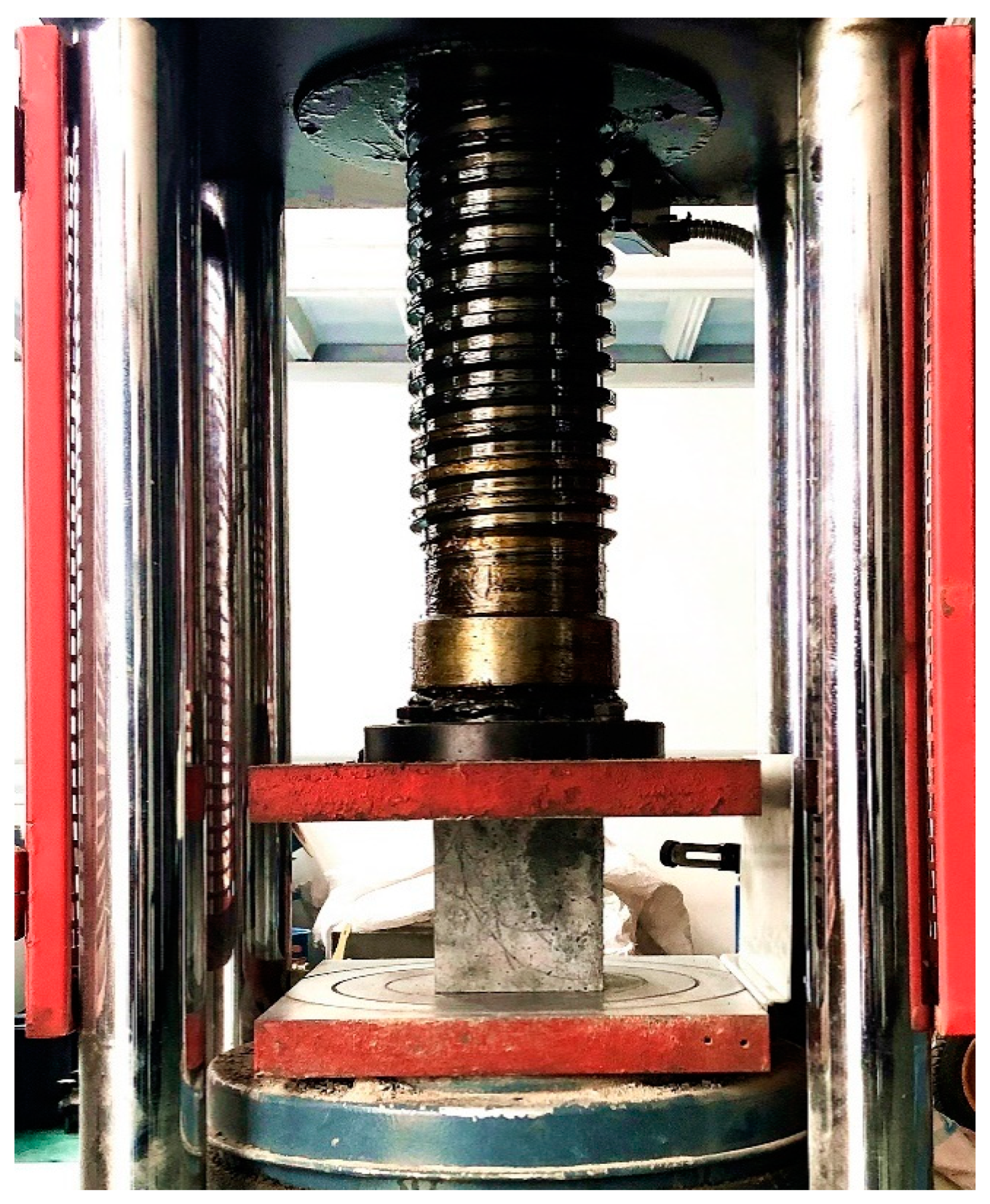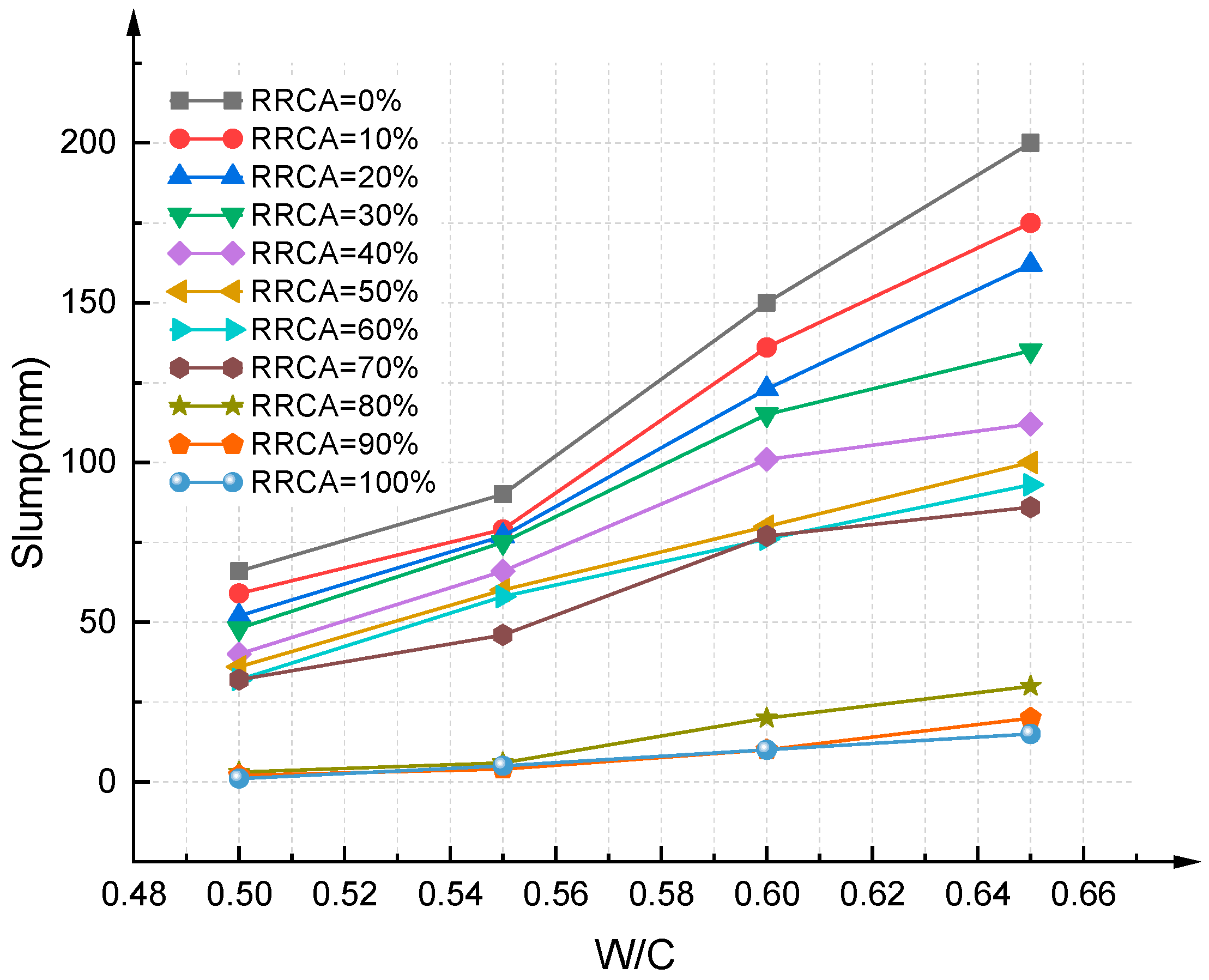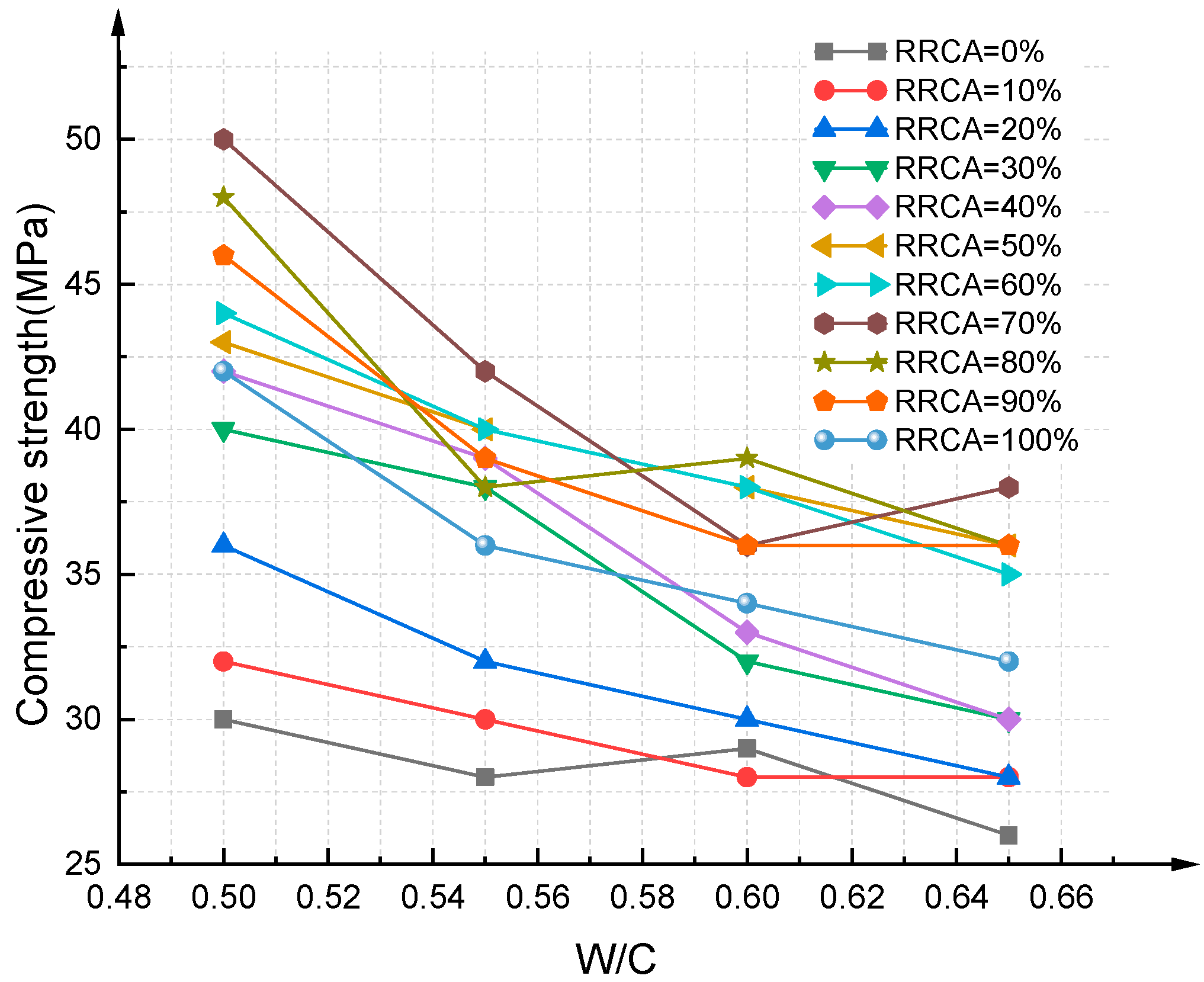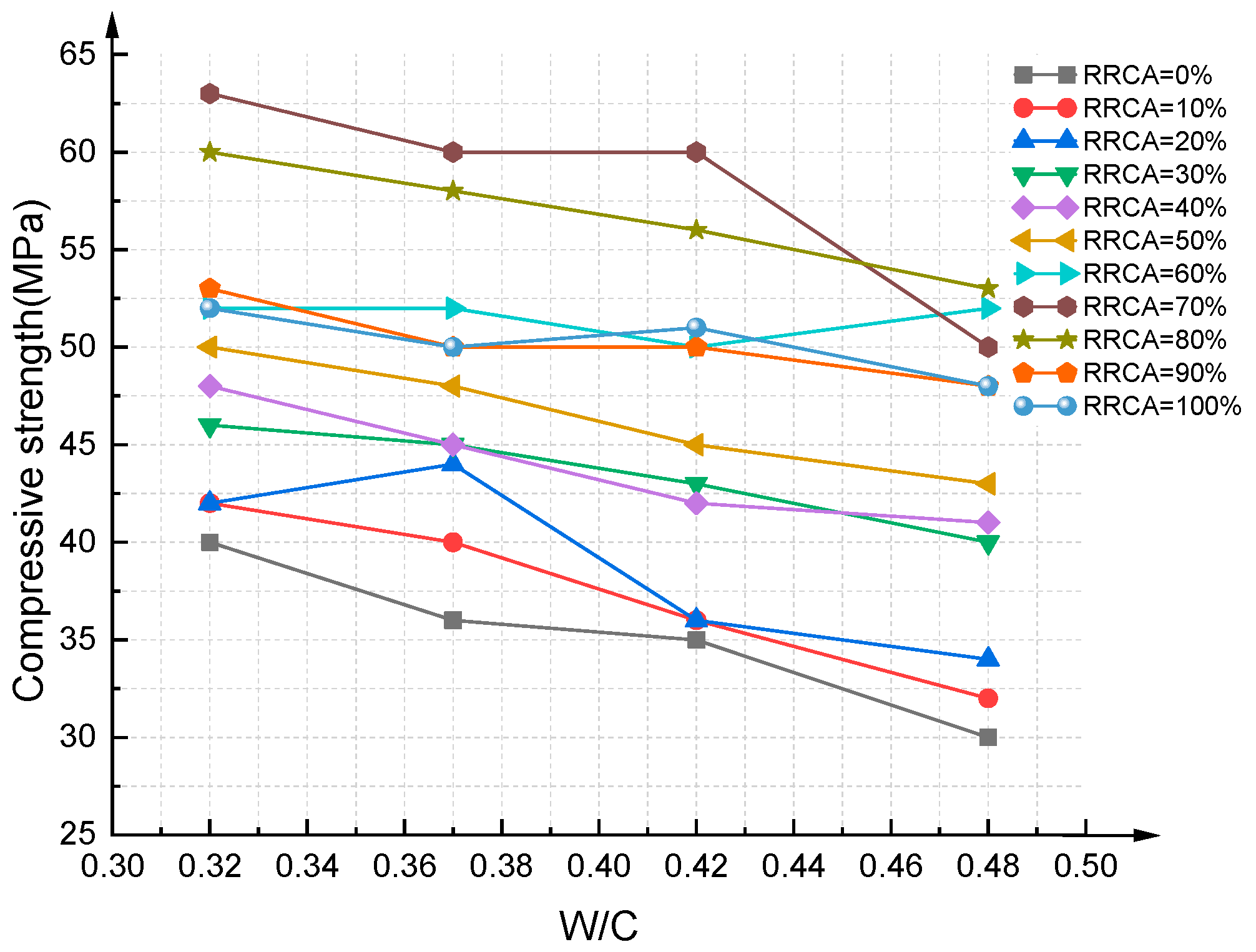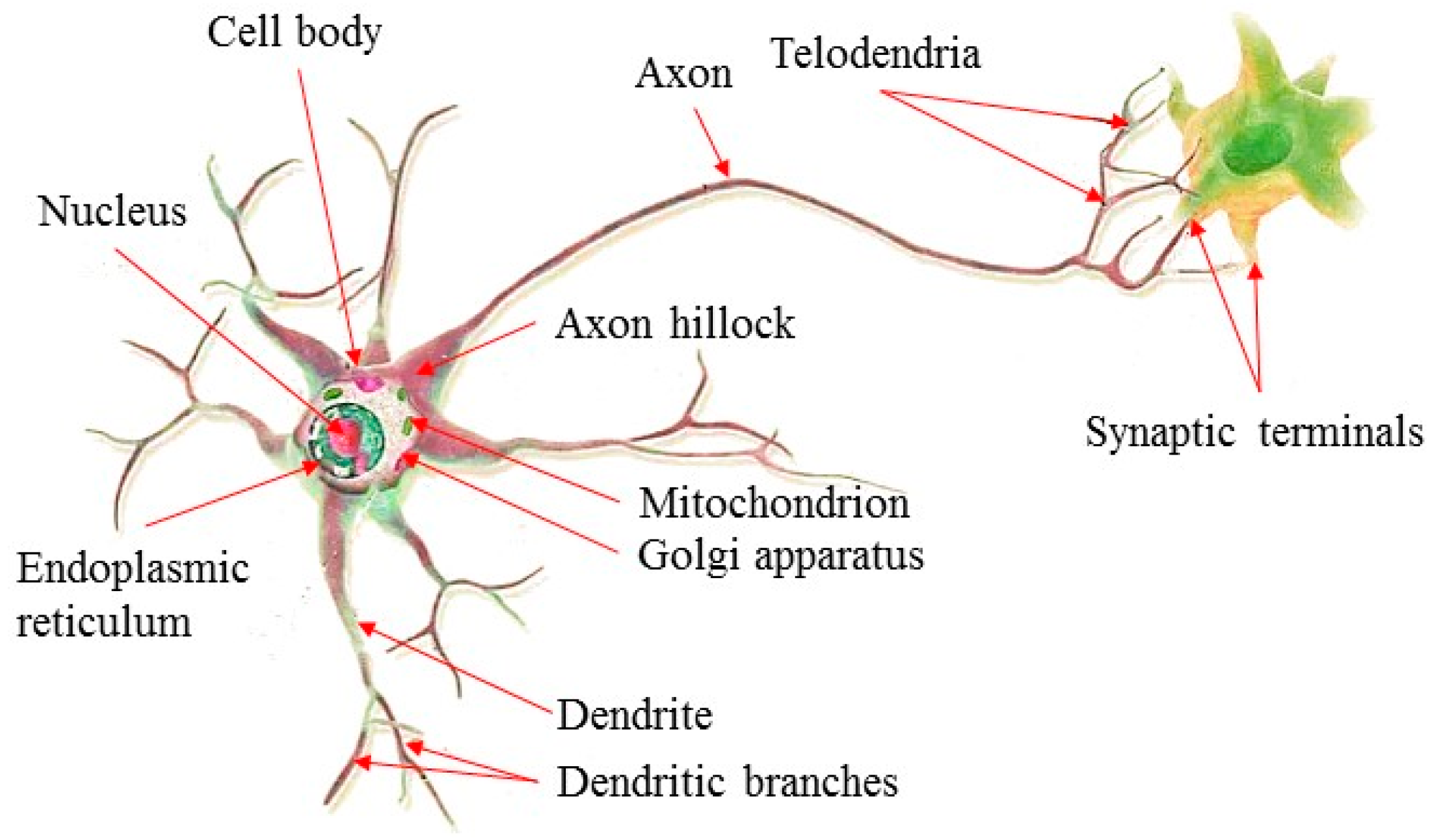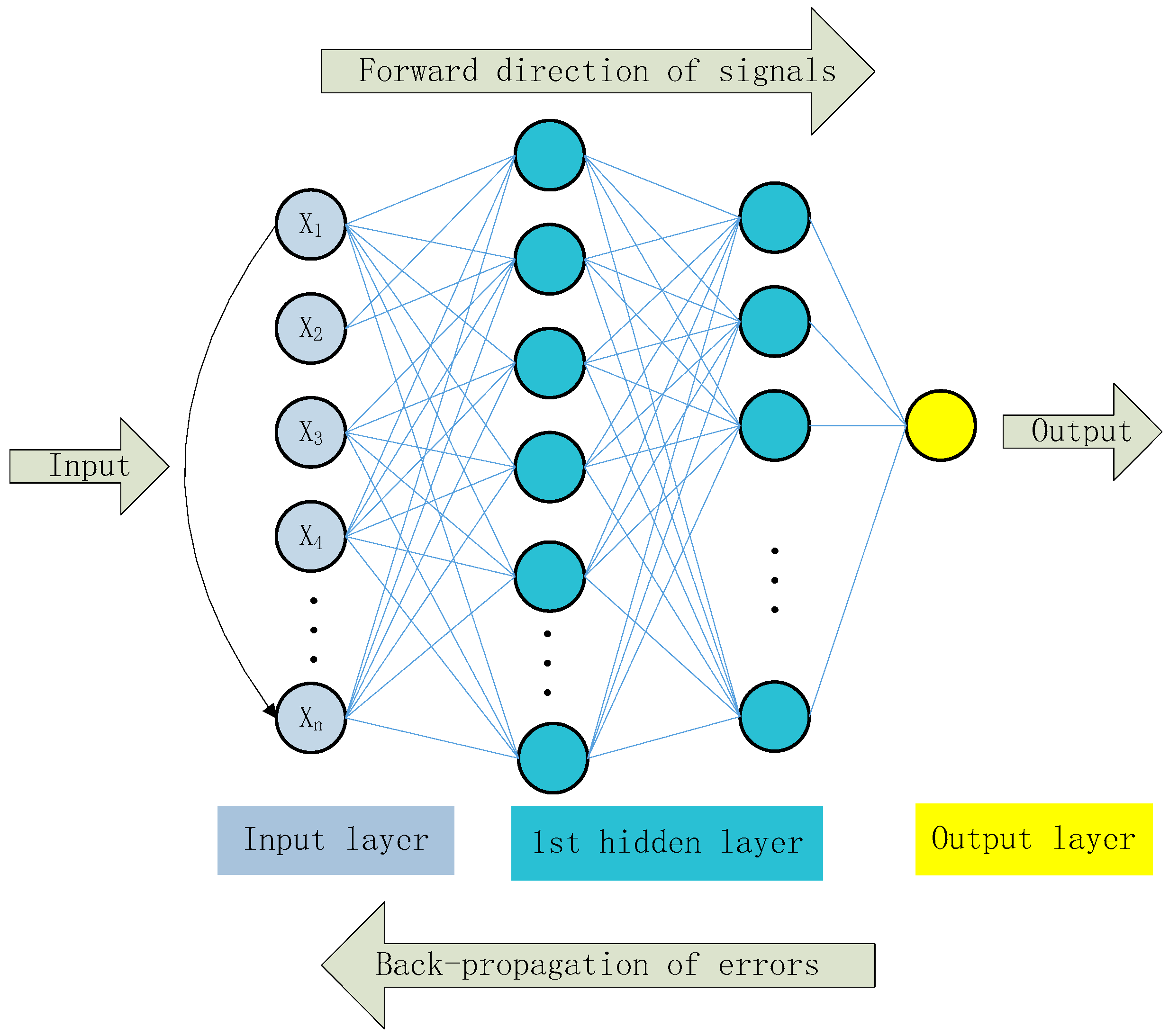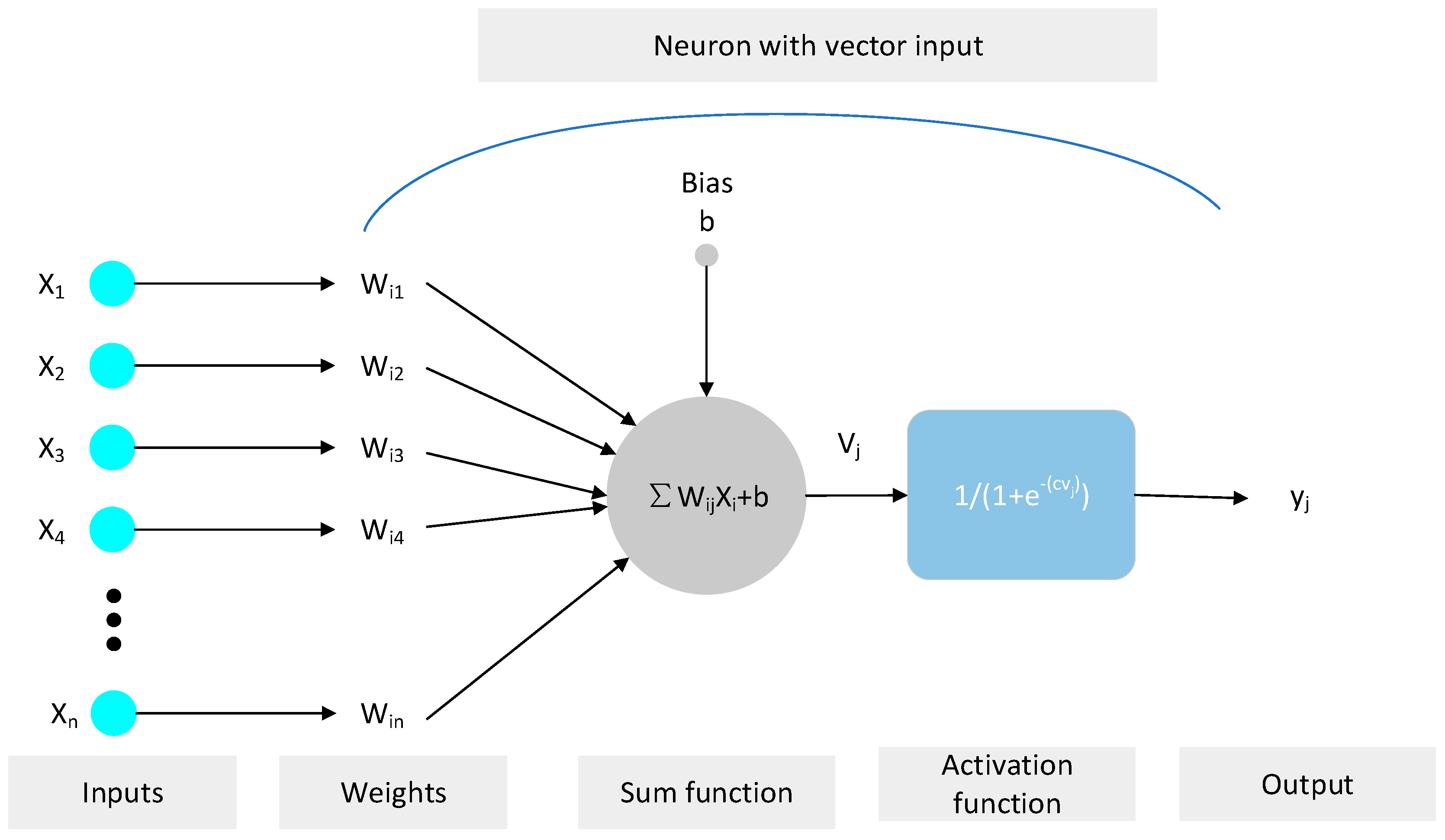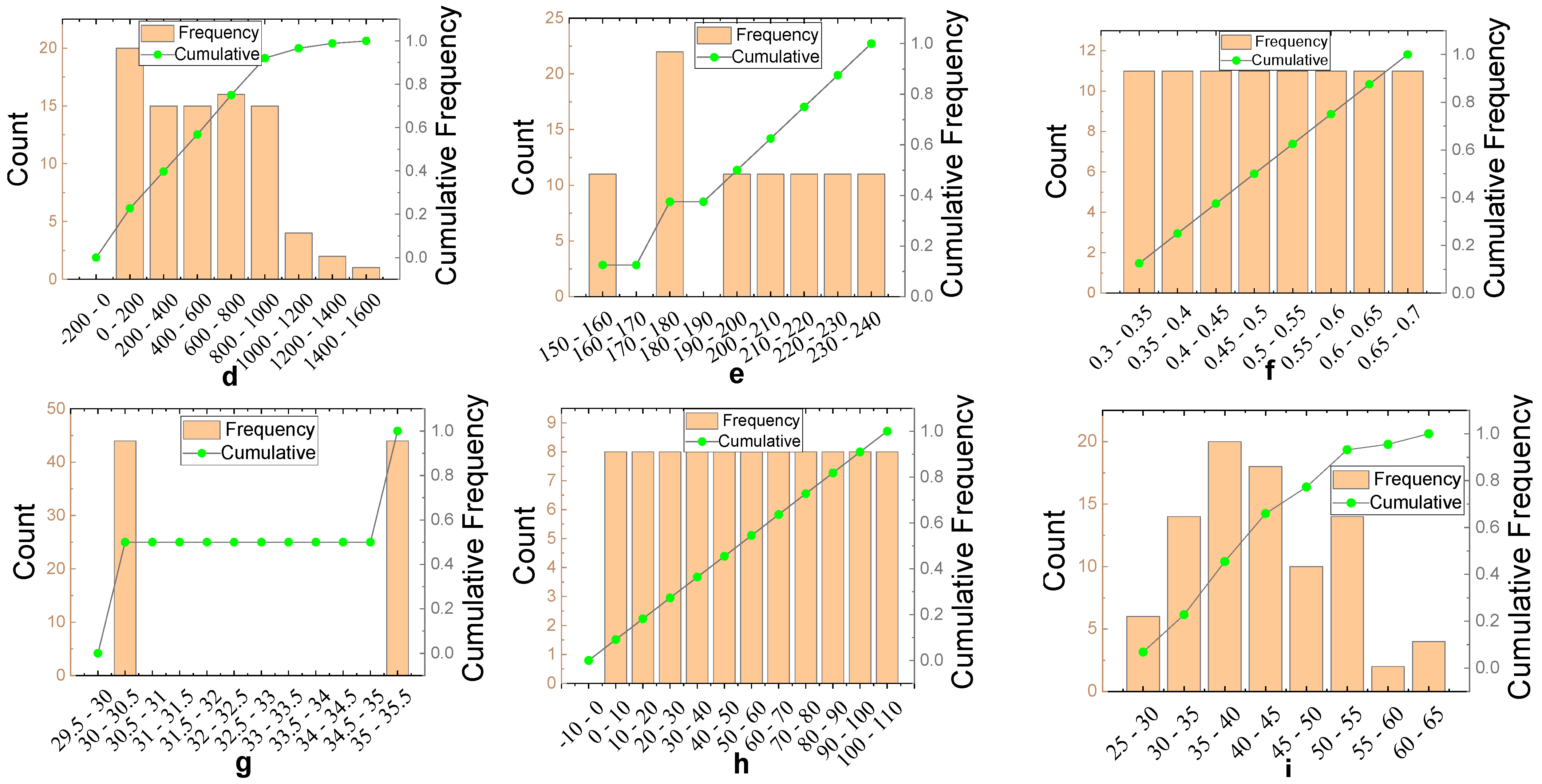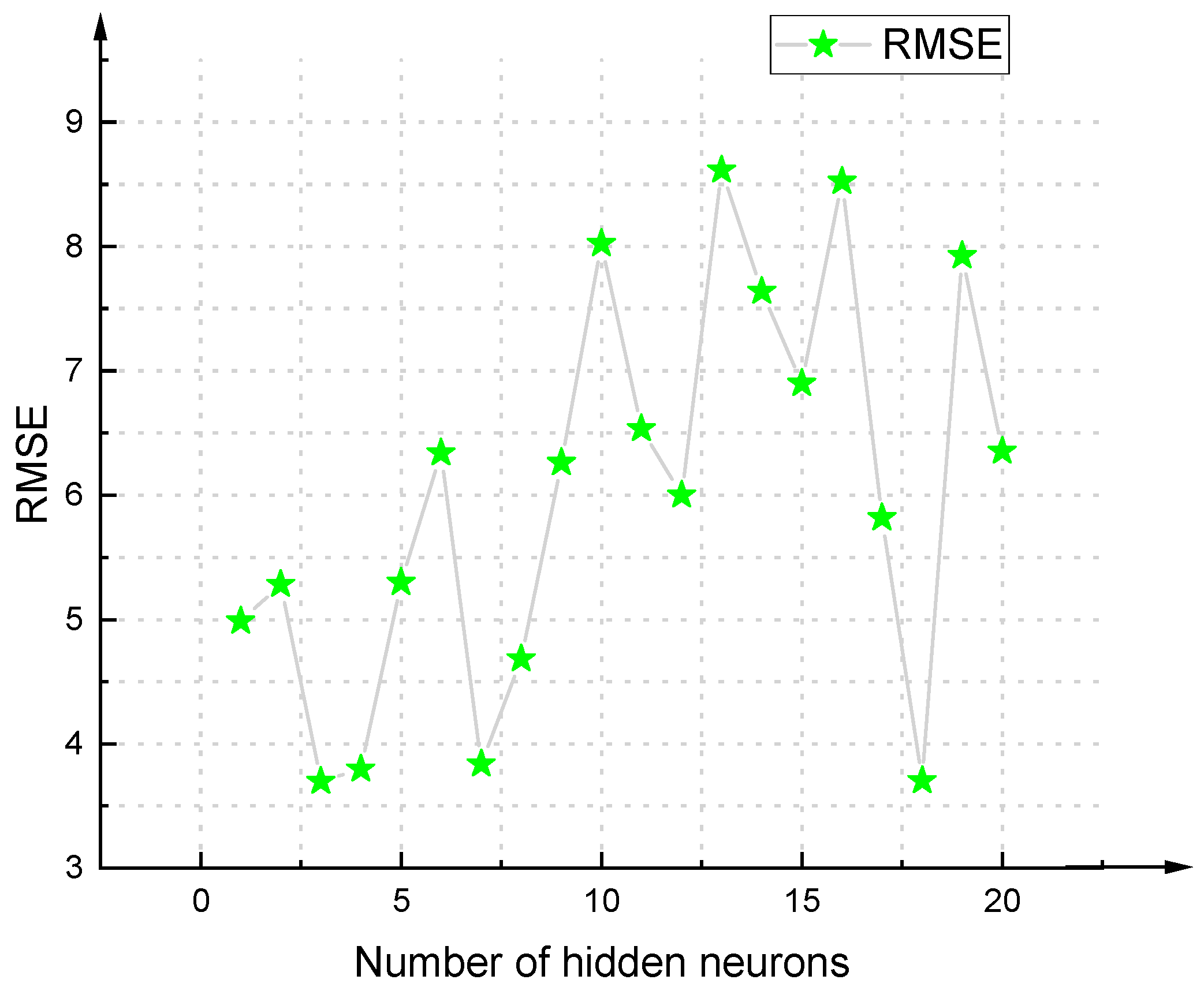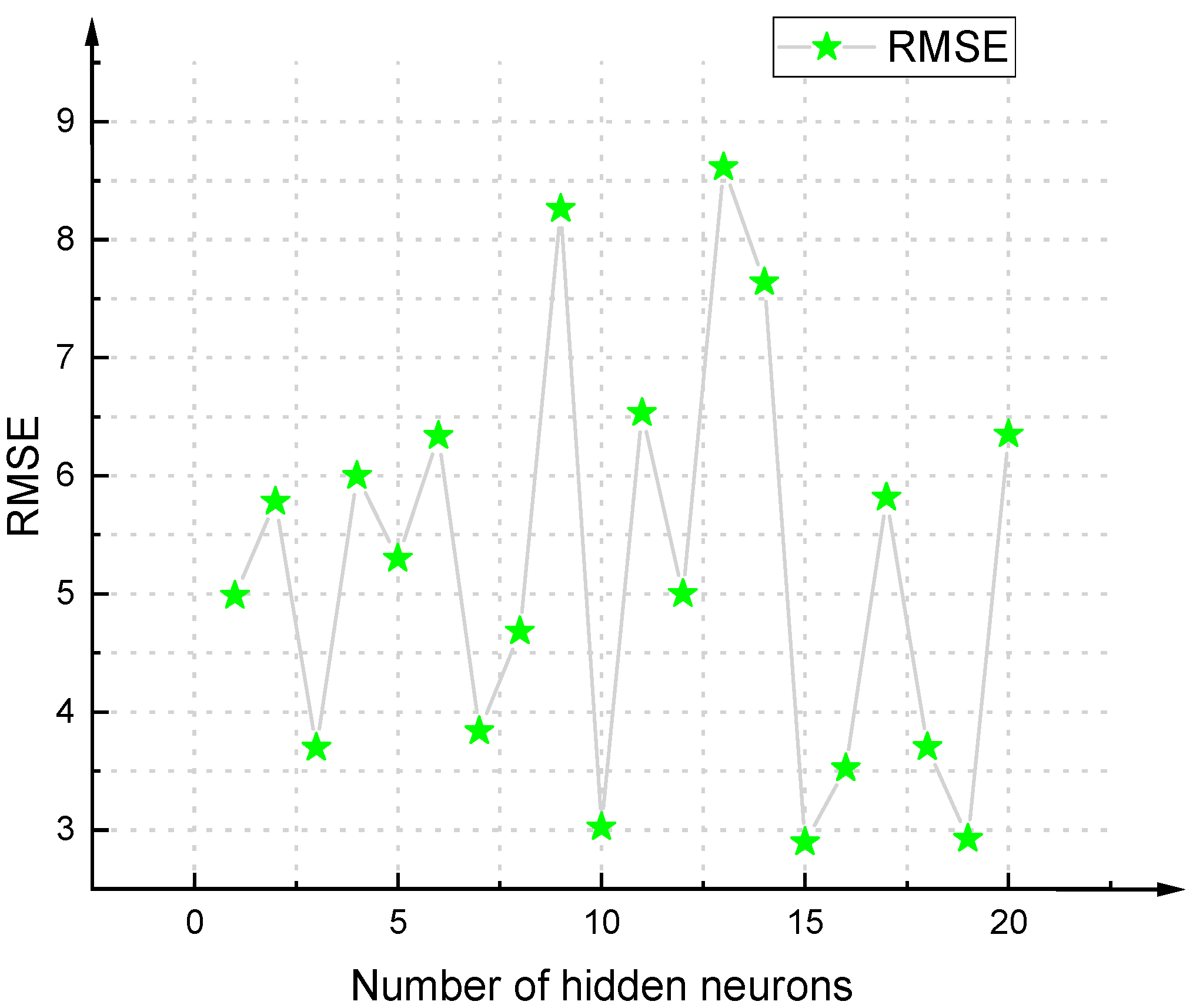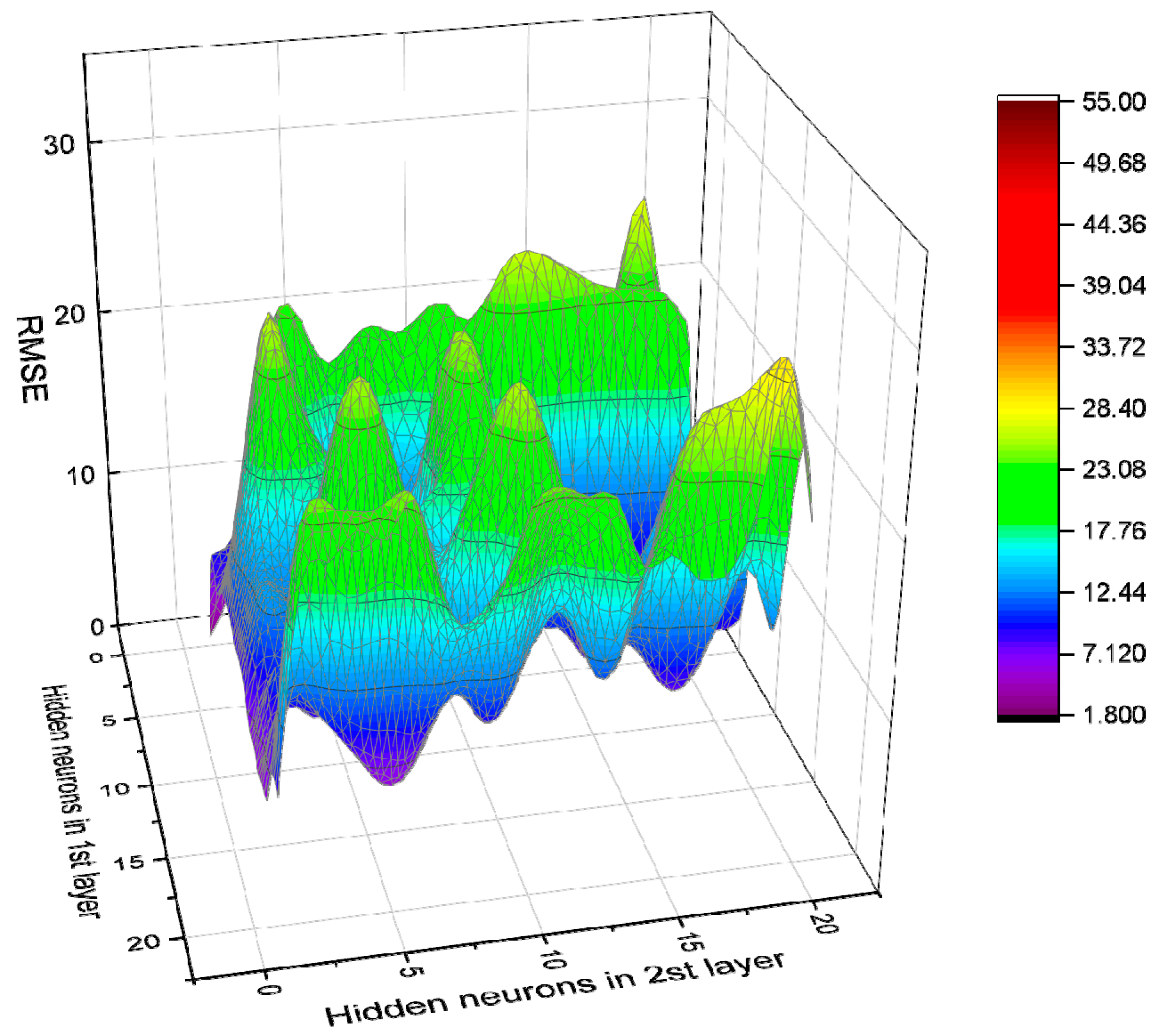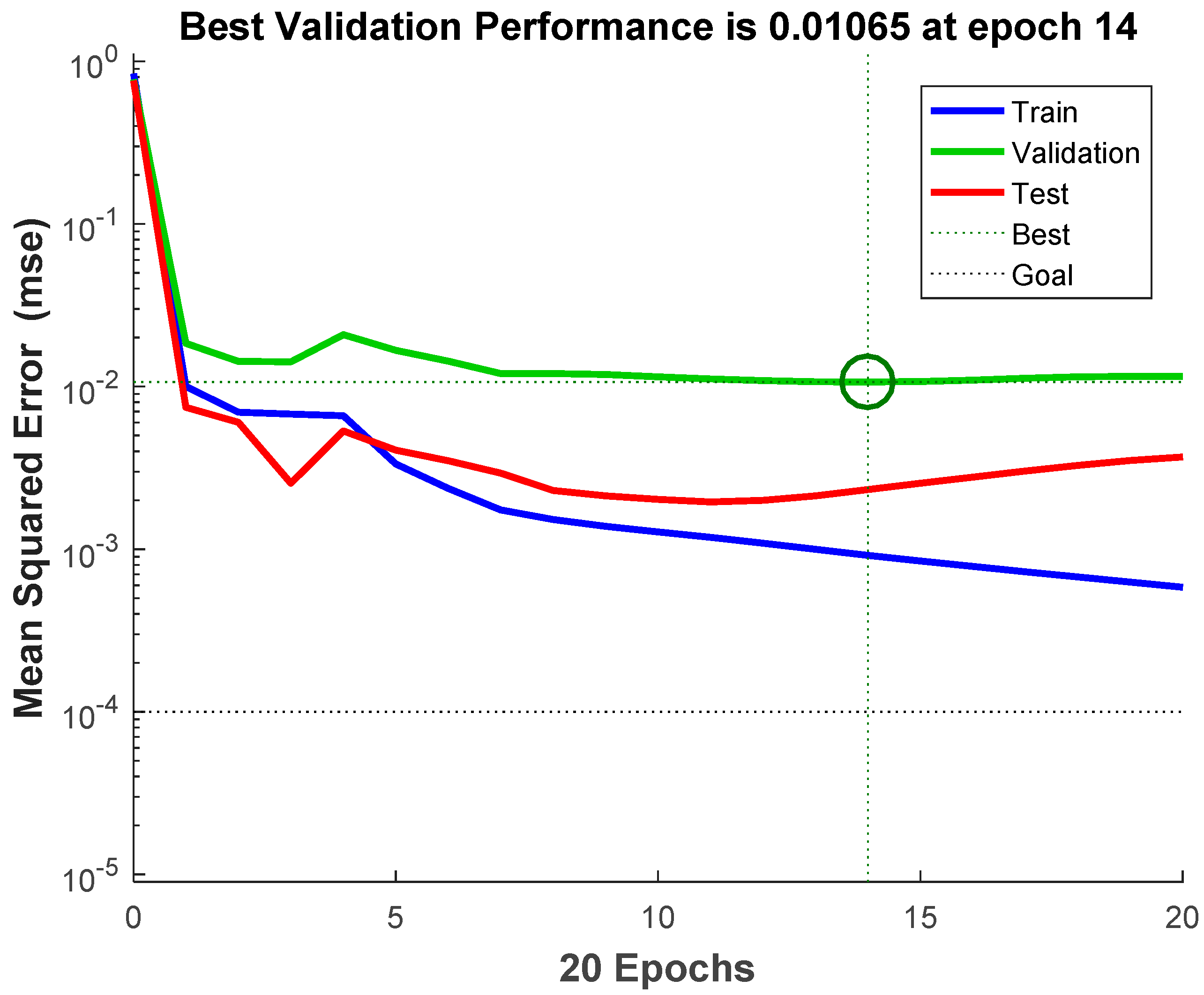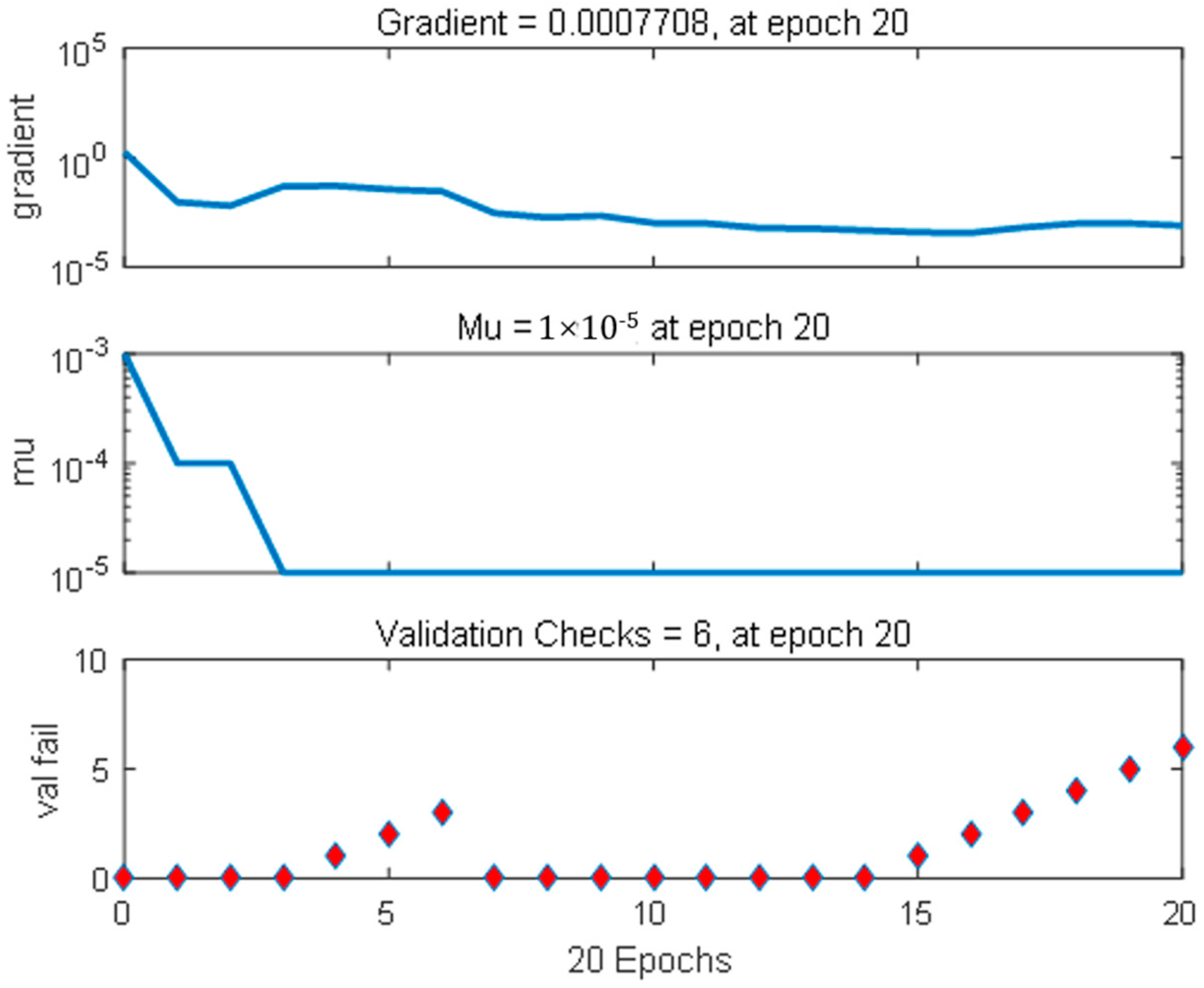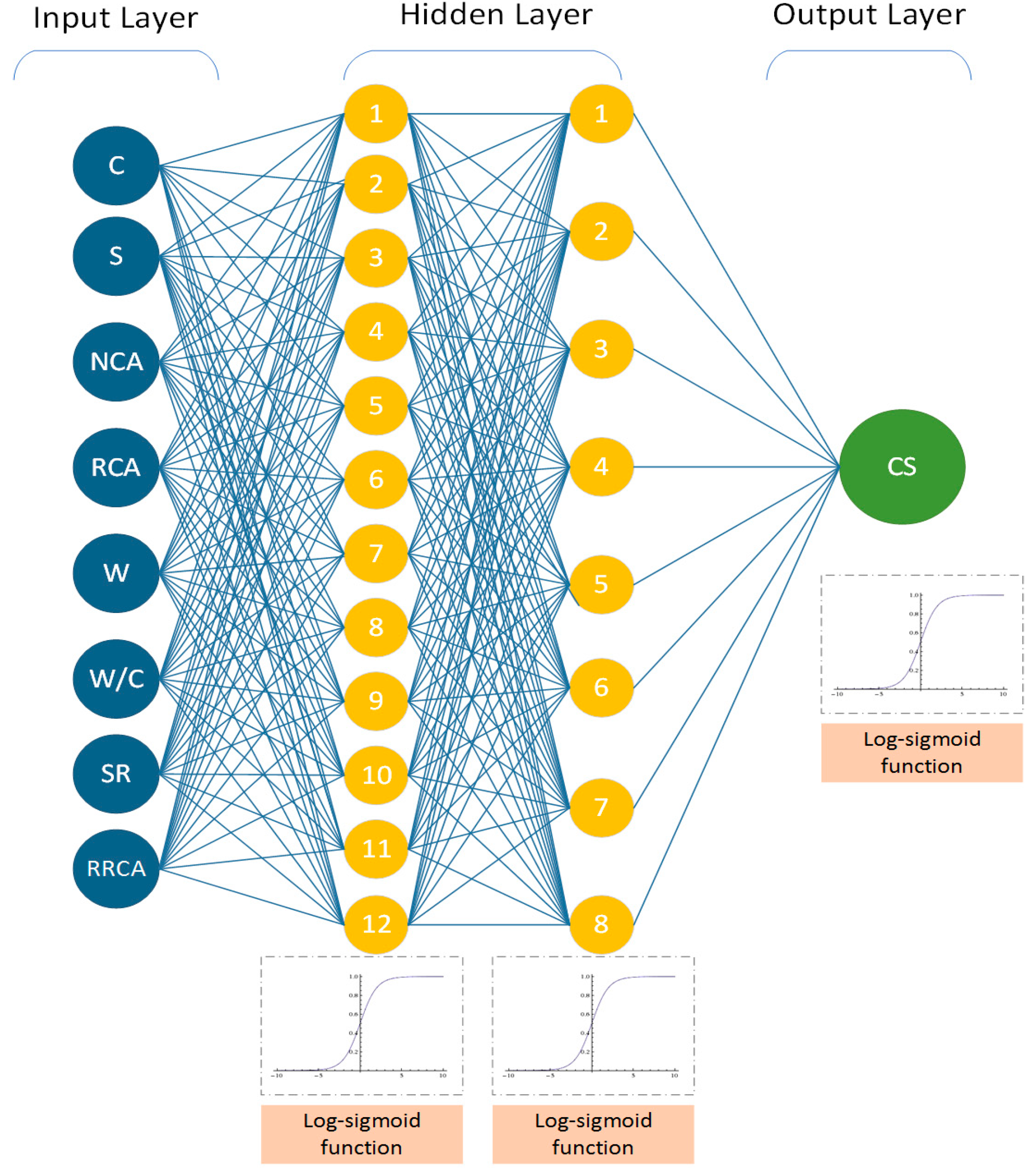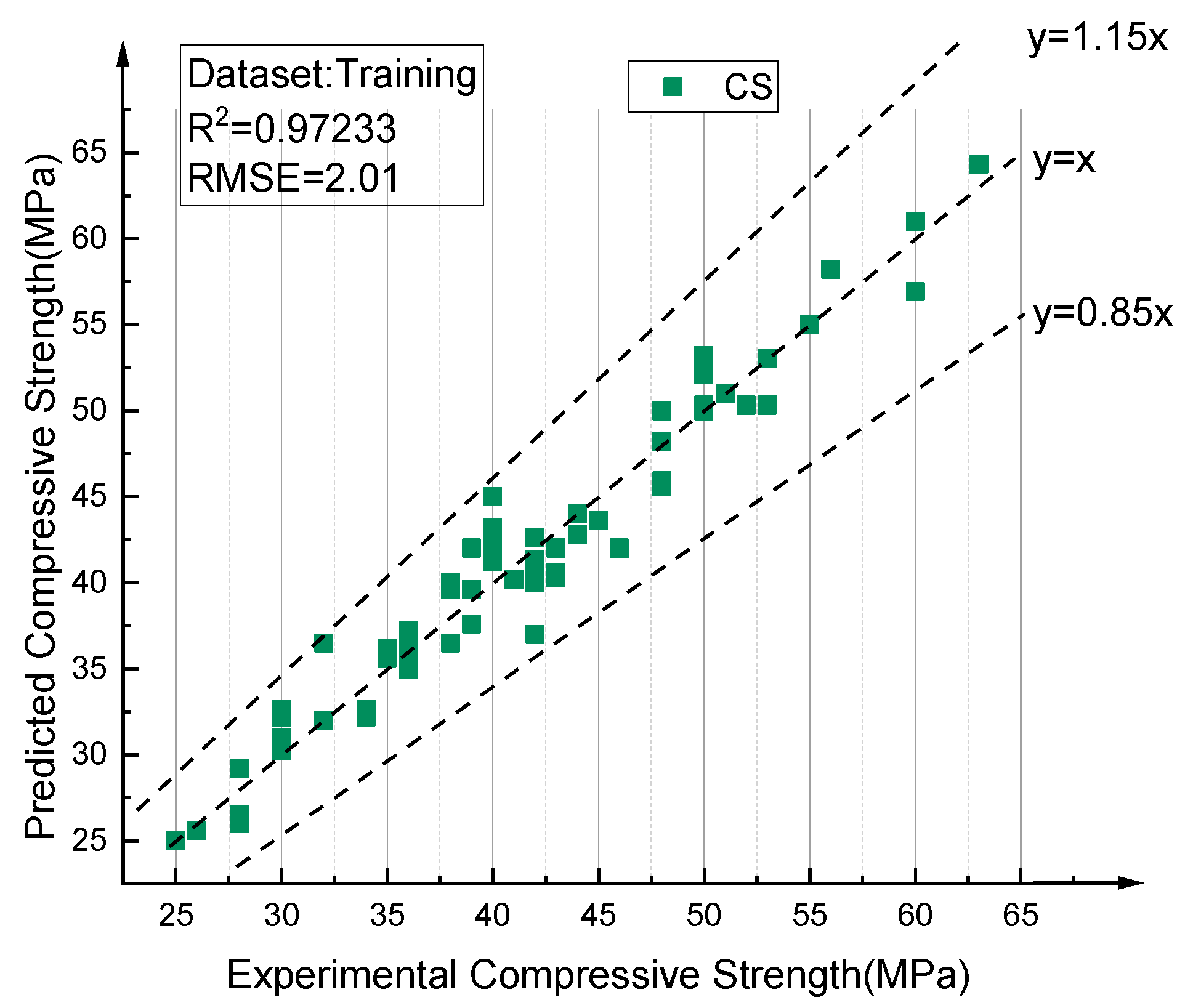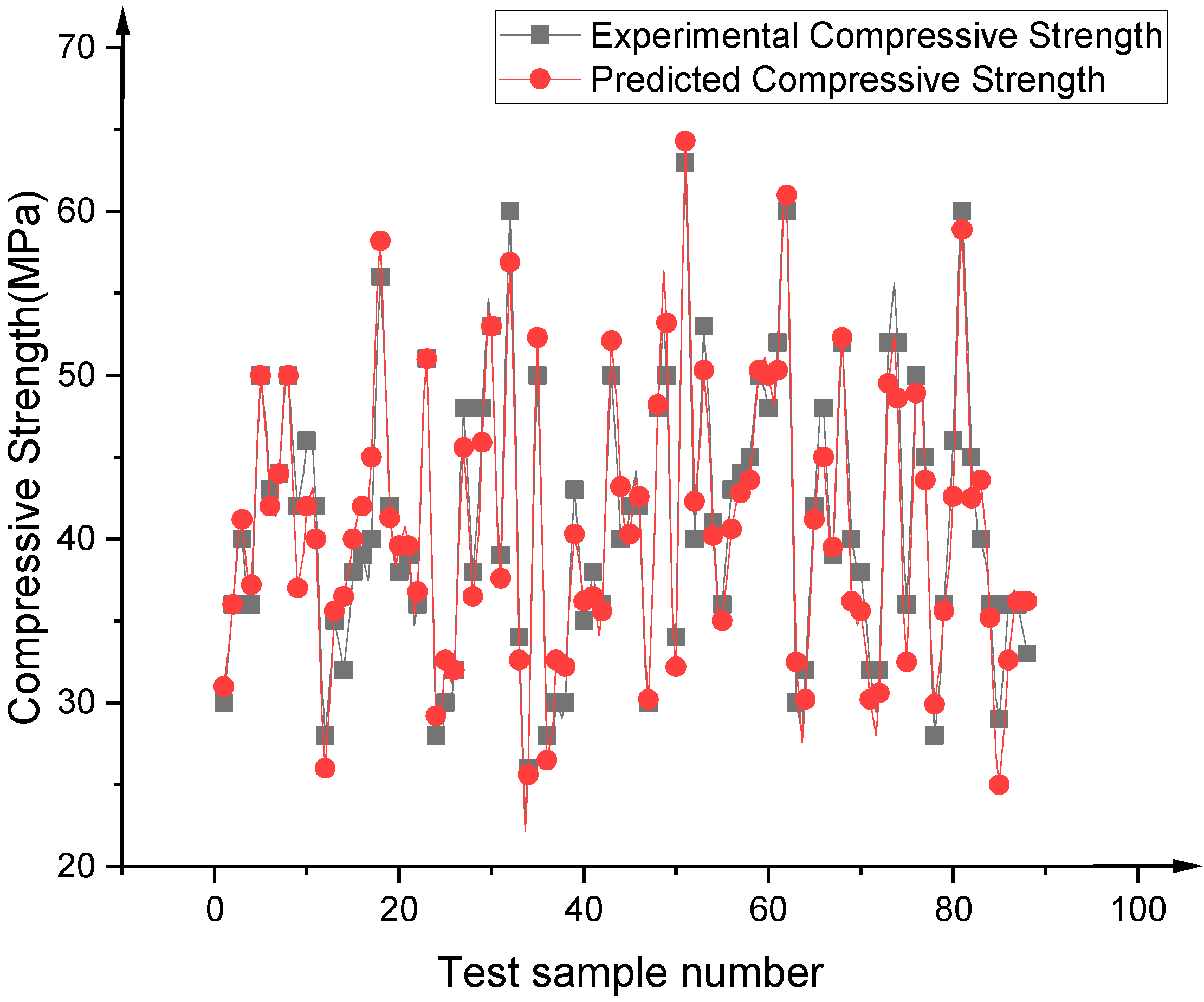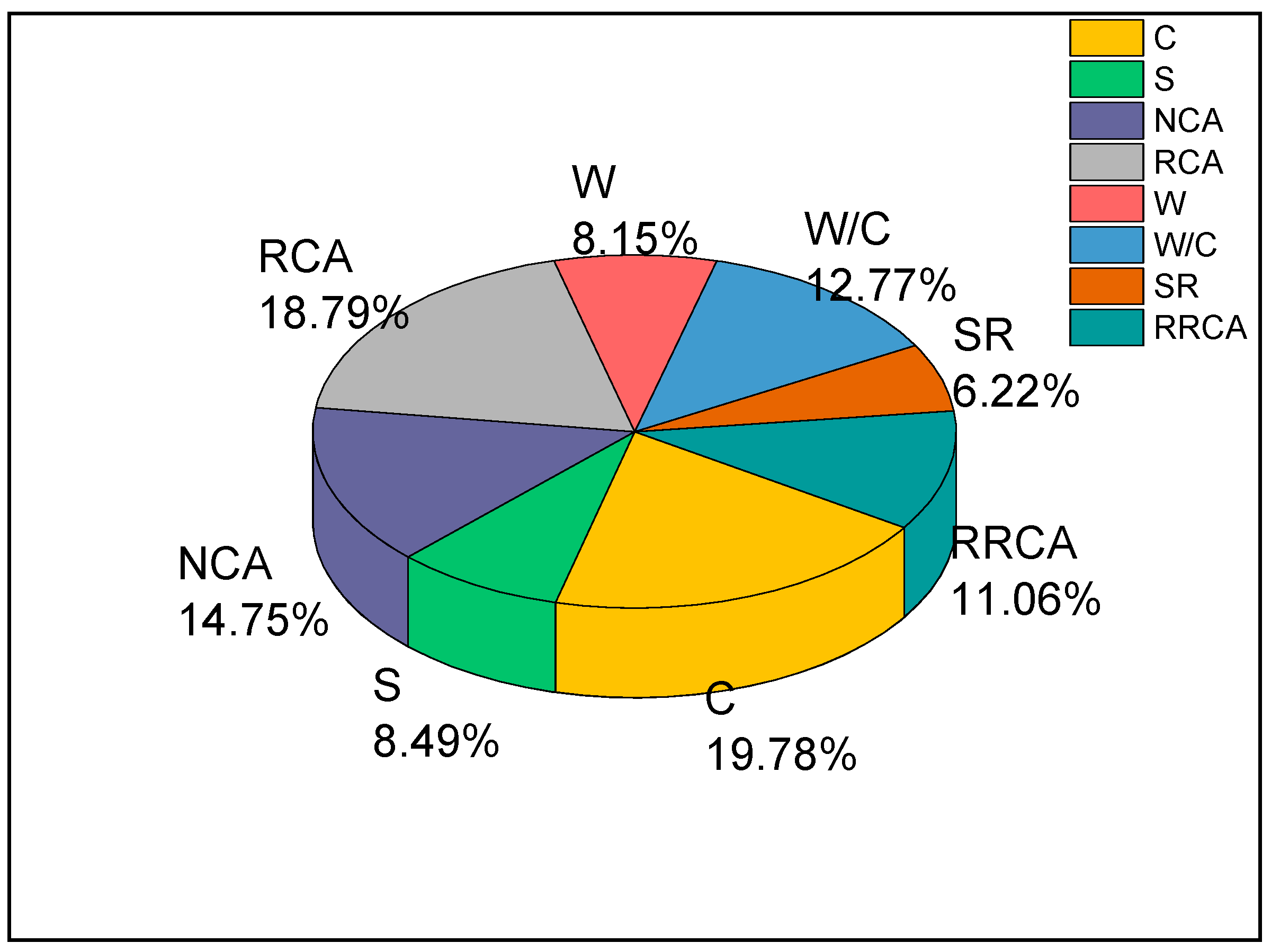1. Introduction
As one of the most widely used construction materials, concrete consumes as much as 10 billion tons of natural aggregates on the planet every year. China produces 8 billion tons of construction wastes on average every year [
1]. The demolition and reconstructing of buildings produces huge amount of construction waste, which further negatively affect the environment. As a matter of fact, lots of countries in the world lack sufficient land to dispose of construction waste. Even countries with comparatively vast territories, like China, face the same difficulty. Without proper treatment, construction waste can result in adverse impacts on environment [
2]. To achieve sustainable development and protect the ecological environment that we live in, people have been seeking a new environmentally protective ways of producing concrete for the construction industry [
3]. Research on recycled aggregate concrete (RAC) started towards the end of last century [
4,
5]. Many scholars have studied ways of making concrete using recycled aggregate (RA), based on which, over 75% of construction waste could be reused when making concrete, thereby reducing CO
2 emissions by a huge amount [
6,
7,
8,
9,
10,
11,
12,
13,
14].
However, due to the powerful absorption performance of RA and the poor adhesion performance between RA and the cementing material, both the compressive strength and the elastic modulus of the RAC are reduced [
15]. Many scholars have studied the factors influencing the compressive strength of RAC, and these mainly include: water content, replacement rate of recycled aggregate, and water–cement ratio [
16,
17]. In 1993, Merlet et al. [
18] proposed a new concrete mixed with waste materials for the first time, and studied its performance when adopting different proportions of fine-grained waste concrete. Heidari A et al. [
19] studied concrete production using waste bricks and conducted tests for compressive strength and bending strength. Tavakoli et al. [
20] studied the replacement of sand in concrete by clay bricks, and the effects of concrete having its sand substituted by different ratios of clay bricks. They figured out the optimal clay brick substitution rate, and finally found no significant changes in concrete performance.
Concrete is the most basic building material. Its quality can seriously affect the safety of the structure, so that both the construction units and the quality inspection departments attach great importance to the compressive strength of concrete. The traditional method of testing the compressive strength of concrete is to reserve a test specimen, which is complicated to carry out. To better detect the compressive strength of concrete, some scholars have studied prediction models for concrete compressive strength [
21,
22]. The basic properties of RAC must be verified by practical experiments, because concrete performance can be greatly affected by the composite material types and the amount of use. However, lab experiments usually require a great amount of manpower, materials, and funds. In this case, a probability model could be adopted to predict the concrete performance. However, when there is a great number of variables and complicated relations between independent variables and dependent variables, the probability model is no longer applicable [
23]. Since RAC is mixed with a large amount of recycled materials and very complicated components, it is hard to accurately predict its performance using traditional regression prediction approaches [
24,
25,
26].
Thanks to the development of information technology, artificial intelligence, big data and other means have been extensively applied in engineering areas. During recent years, artificial neural network (ANN), an artificial intelligence algorithm inspired by nature, has been widely used in the modeling field for practical problems. ANN can perceive complex nonlinear relationships between dependent variables and independent variables, and effectively solve many complex engineering problems. It has been widely used in civil engineering, such as groundwater monitoring, structure recognition, structural damage monitoring, traffic engineering, material behavior modeling and foundation settlement prediction, etc. Wagh et al. [
27] used an ANN model to detect irrigation use of groundwater, and showed excellent performance with 13 physical and chemical characteristics as input parameters. Deshpande et al. [
28] predicted the compressive strength of concrete by means of ANN, model tree and nonlinear regression, and the results indicated that the ANN model provided the highest accuracy. Xiong et al. [
29] obtained structural images after geological disasters using unmanned aerial vehicles by virtue of ANN image recognition technology, and judged whether regional structures had collapsed using this technology, and evaluated the damage after disasters on the basis of structural appearance characteristics. Lv, Y et al. [
30] came up with a model based on a BP neural network and grey theory to predict the settlement of a foundation pit. The results suggested that both models boasted favorable predictive capacity. Lots of scholars have used ANN to predict concrete performance [
31,
32,
33,
34,
35]. Due to the powerful learning ability of ANN, some scholars have tried to predict concrete performance using ANN by taking the material components of the concrete as parameters [
36]. Torre et al. [
37] constructed a multi-layer perceptron model to accurately predict the compressive strength of high-performance concrete. Topçu et al. [
38] used ANN to predict the compressive strength and the splitting tensile strength of recycled aggregate concrete containing silica fume. Khademi et al. [
39] adopted three artificial technologies—ANN, ANFIS and MLR—to predict the compressive strength of RAC, for which the results showed that ANN was able to predict the compressive strength of RAC more accurately than the other two. To predict the compressive strength of the self-compacting high-strength concrete mixed with silica fume, fly ash, and blast furnace slag aggregates, Jamaldin et al. [
40] established a neural network model, based on which they obtained good predictions of the experimental results. At present, ANN is mainly used to predict the compressive strength of natural aggregate concrete and concrete containing blast furnace slag and fly ash, but similar research has rarely been performed on RAC due to its complex composition. RAC is a new type of material that is different from traditional concrete in terms of both the concrete components and its performance. It is hard to predict the compressive strength of RAC using the regressive statistical method. ANN has the ability to capture the nonlinear and complex relationships between variables from existing actual data. Therefore, the application of ANN in the prediction of RAC performance is a significant research topic.
To make up the gap of using ANN for predicting the RAC compressive strength and test the compressive strength of RAC in a more efficient manner, in this study, a RAC compressive strength prediction model was established based on an artificial neural network. The training data set was obtained through experiments, which was used to develop the ANN model. Meanwhile, a neural network model with two hidden layers was constructed, which was trained and tested using 88 groups of data that were obtained from experiments. The established neural network model had 8 input parameters and 1 output parameter. The prediction results were compared with the test results, verifying the reliability of the model. Finally, a sensitivity analysis was carried out on the parameters to analyze the influences of the RAC parameters on its compressive strength.
6. Sensitivity Analysis
In the field of neural networks, many scholars have conducted research on new ANN learning rules, restructuring the architecture of the neural network in order to achieve better application. ANN is called a “black box”, aiming to convert the input into an ideal output. Being different from other traditional numerical analysis models, it is difficult to use ANN to interpret the relations between independent variables and dependent variables. The input parameters contain the required output information, while the remaining additional features and information in the input parameters are beneficial for improving the prediction capability. However, usually, some redundant parameters containing little information are also included, which do not improve the information, and can affect the performance of the learning algorithm. The purpose of the sensitivity analysis is to determine the impact of the input parameters in the mathematical model on the output result, thereby enhancing the understanding of the input and output variable relationships in the model. The sensitivity analysis can be used to determine the contribution of a single input parameter to the output parameter, thus reducing redundant parameters [
71]. In this study, a relative analysis was conducted using the sensitivity analysis method based on weight, as proposed by Milne [
72]; see Formula (10), below:
In the formula, is the importance of the input parameters, which are referred to as contributory factors; is the connection weight between the two connected neurons; is the connection weight between the input layer and the hidden layer, and is the connection weight between the output layer and the hidden layer (product of the weight of the first hidden layer and the weight of the second hidden layer). all represent the input layer neuron, is the number of the input parameters, and is the number of hidden neurons (first hidden layer).
Table 8 shows the connection weight between the input layer neurons and the hidden layer neurons of the optimal BPNN model.
Figure 28 shows the effect of a single parameter on the prediction of RAC compressive strength. It can be seen that the parameter of cement content has the most significant impact on predicted compressive strength of RAC, with an impact factor reaching 19.78%. This indicates that the cement content is the factor that affected the compressive strength of the recycled concrete the most in this study. The impact factors of RCA, NCA, and W/C were, respectively, 18.79%, 14.75%, and 12.77%, indicating that the content of the aggregate has a greater impact on the compressive strength of RAC, while the RCA has the greatest impact. Second, the impact factors of the RRCA, S, W, and SR reached 11.06%, 8.49%, 8.15%, and 6.22%, respectively. It can be seen from the results of the sensitivity analysis that none of the eight input parameters in this study had an impact factor that was too low (lower than 2%). All eight parameters provided useful information for predicting RAC compressive strength.
7. Conclusions
RAC is an environmentally friendly construction material with great development potential, and is in line with the concept of sustainable development. With a proper design of mixing proportions, RAC is able to achieve the same performance as ordinary concrete. However due to the impact of the original mortar and cement residual of the old concrete on the recycled aggregate, the compressive strength of RAC is usually weaker than that of ordinary concrete. To guarantee the safe use of RAC, it is necessary to predict the compressive strength of the RAC. In this paper, ANN was applied for the prediction of RAC compressive strength, which verified the usability of the model and allowed the following conclusions to be drawn:
- (1)
A total of 88 different mix proportions of RAC were designed, and the effects of different water–cement ratios and replacement rates of recycled aggregate regenerated aggregate on RAC compressive strength were studied, with water–cement ratios of 0.35–0.65, and RRCA of 0–100%. The experimental results show that the performance of RAC produced from recycled aggregate can be comparable to that of ordinary concrete. With reasonable mixing proportion design, the RAC compressive strength was able to reach 63 MPa. Under the same water–cement ratio conditions, the RAC slump decreases with increasing RRCA. In addition, the best RRCA rate is 70%.
- (2)
A total of 840 BPNN models were developed using a trial-and-error approach, for which the C (kg/m3), S (kg/m3), NCA (kg/m3), RCA (kg/m3), Water (kg/m3) W/C, SR (%), and RRCA (%) were taken as the input parameters. Meanwhile, based on the maximum correlation coefficient R2, the optimal BPNN model (8–12–8–1) was selected to predict the RAC compressive strength. The predicted values and the experimental values exhibited good fitting. In addition, the correlation coefficient between the predicted value and the experimental value was 0.96650, and the RMSE reached 2.42.
- (3)
The sensitivity analysis shows that, all eight of the selected variables was able to greatly affect the compressive strength of RAC; among them, the cement content was the most influential one with respect to its effect on RAC compressive strength. Its impact factor reached 19.78%, while the impact degrees of the other parameters were in the following order: RCA > NCA > W/C > RRCA > S > W > SR.
It can be seen that ANN can help to achieve accurate prediction of RAC compressive strength, and can be applied in other types of concretes. To improve the prediction accuracy, more sample data could be collected during the testing stage, thereby increasing the sample amount of the training set.
